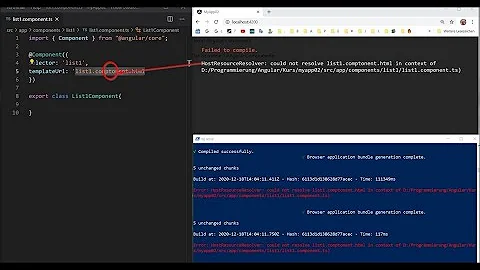Angular Template cache not working
Solution 1
You have to also specify the templates module as a dependency of your module. For example:
angular.module('myApp', ['templates', 'ngDialog'])
Hope this helps.
Solution 2
This answer is for anyone else that may have run across this issue, but they're sure they did include the dependency as the accepted answer states:
Make sure to verify the "key" you're using matches. In my scenario, the following was happening:
$templateCache.put('/someurl.html', 'some value');
but it was looking for 'someurl.html'. Once I updated my code to:
$templateCache.put('someurl.html', 'some value');
Everything started working.
Solution 3
You is one more method by which you can even remove your dependency on $templatecache.
You can use this gulp plugin which can read your routes,directives and replace the templateUrl with the template referenced in the templateUrl.
src
+-hello-world
|-hello-world-directive.js
+-hello-world-template.html
hello-world-directive.js:
angular.module('test').directive('helloWorld', function () {
return {
restrict: 'E',
// relative path to template
templateUrl: 'hello-world-template.html'
};
});
hello-world-template.html:
<strong>
Hello world!
</strong>
gulpfile.js:
var gulp = require('gulp');
var embedTemplates = require('gulp-angular-embed-templates');
gulp.task('js:build', function () {
gulp.src('src/scripts/**/*.js')
.pipe(embedTemplates())
.pipe(gulp.dest('./dist'));
});
gulp-angular-embed-templates will generate the following file:
angular.module('test').directive('helloWorld', function () {
return {
restrict: 'E',
template:'<strong>Hello world!</strong>'
};
});
Solution 4
My 2 cents (coz i also banged my head on this.)
1) Ensure that you have a dependency in your main module. (if you are creating a separate module for templates).
2) Ensure that leading \ are taken care of in template urls.
3) Ensure that text casing used in file names matches with that used in template urls. (YES this one).
Related videos on Youtube
Ben Taliadoros
I am a Software Engineer working for a cyber security company in London. Answer my questions and I will send you sweets.
Updated on July 16, 2022Comments
-
 Ben Taliadoros almost 2 years
Ben Taliadoros almost 2 yearsI have a project using gulp and angular. I want to click a button and a pop up containing the html to show.
In the build.js file i have the following code:
gulp.task('templates', function() { gulp.src(['!./apps/' + app + '/index.html', './apps/' + app + '/**/*.html']) .pipe(plugins.angularTemplatecache('templates.js', { standalone: true, module: 'templates' })) .pipe(gulp.dest(buildDir + '/js')); });in my app.js file i have:
.controller('PopupCtrl', function($scope, ngDialog) { $scope.clickToOpen = function () { ngDialog.open({ template: 'templates/popup.html' }); }; })I get an error on clicking the button:
GET http://mylocalhost:3000/templates/popup.html 404 (Not Found)My templates.js file contains:
angular.module("templates", []).run(["$templateCache", function($templateCache) { $templateCache.put("templates/popup.html", "my html") ...etcWhy does the template cache not recognise the call to templates/popup.html and show what is in the cache rather than looking at the 404'd URL?
Just to say what I have tried, I manually copied the template file into the directory it was looking and it found it. This is not the solution though as I want it taken from cache.
Thanks
-
tmanion over 8 yearsHappened to me too. Darn Tootin!
-
Burjua over 8 yearsUpper and lower case matter too!
-
 jsbisht almost 8 yearsI was generating the '$templateCache' using gulp and the path were starting from the child folder of the actual folder referenced in 'templatesUrl'. This helped me figure out that.
jsbisht almost 8 yearsI was generating the '$templateCache' using gulp and the path were starting from the child folder of the actual folder referenced in 'templatesUrl'. This helped me figure out that. -
Cédric Guillemette over 7 yearsI just ran into this problem and it turns out there was a space in front of the URL. 🤦
-
 adam0101 over 6 yearsIn my case, I had an interceptor appending the app version to the url for cache busting. So I had to change my interceptor to not do that if the url was already loaded into the
adam0101 over 6 yearsIn my case, I had an interceptor appending the app version to the url for cache busting. So I had to change my interceptor to not do that if the url was already loaded into the$templateCache. -
 Gondy about 6 yearsThank you! You saved my day! (even 4 years later in 2018 :))
Gondy about 6 yearsThank you! You saved my day! (even 4 years later in 2018 :))







